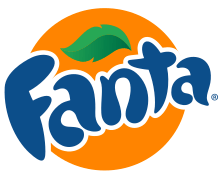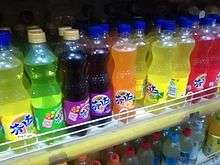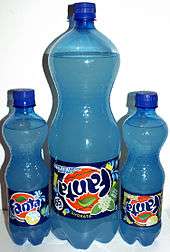Fanta
 Fanta Logo | |
| Manufacturer | The Coca-Cola Company |
|---|---|
| Country of origin | Germany |
| Introduced | 1940 |
| Variants | See International availability |
| Related products | Sunkist, Crush, Slice, Mirinda, Tango, Bluna |
Fanta is a brand of fruit-flavored carbonated drinks created by The Coca-Cola Company and marketed globally. There are more than 100 flavours worldwide. The Fanta drink originated as a cola substitute in Nazi Germany under a World War II trade embargo for Coca-Cola ingredients in 1940.
History
During WWII, a trade embargo was established against Nazi Germany – making the import of Coca-Cola syrup difficult.[1] To circumvent this, Max Keith, the head of Coca-Cola Deutschland (Coca-Cola GmbH) decided to create a new product for the German market, using only ingredients available in Germany at the time, including whey and apple pomace—the "leftovers of leftovers", as Keith later recalled.[1][2] The name was the result of a brief brainstorming session, which started with Keith's exhorting his team to "use their imagination" (Fantasie in German), to which one of his salesmen, Joe Knipp, immediately retorted "Fanta!"[2]
The plant was effectively cut off from Coca-Cola headquarters during the war. After the war, The Coca-Cola Company regained control of the plant, formula, and the trademarks to the new Fanta product—as well as the plant profits made during the war.[1][2]
During the war the Dutch Coca-Cola plant in Amsterdam (N.V. Nederlandsche Coca-Cola Maatschappij) suffered the same difficulties as the German Coca-Cola plant. Max Keith therefore also put the Fanta brand at the disposal of the Dutch Coca-Cola plant, of which he had been appointed the official caretaker. Dutch Fanta had a completely different recipe from German Fanta, elderberries being one of the main ingredients.[3]
Fanta production was discontinued when the German and Dutch Coca-Cola branches were reunited with their parent company. Following the launch of several drinks by the Pepsi corporation in the 1950s, Coca-Cola competed by relaunching Fanta in 1955. The drink was heavily marketed in Europe, Asia, Africa and South America.[4]
Marketing
United States
Fanta is known for its upbeat colorful advertising; in the United States, it showcases The Fantanas, a group of young female models, each of whom promotes an individual Fanta flavor. For the re-introduction of Fanta in the United States, Coca-Cola worked with the ad agency Ogilvy (NYC) in 2001. After a brainstorming session, the Ogilvy creative team of Andrea Scaglione, Andrew Ladden and Bill Davaris created the tagline "Wanta Fanta!" which became the jingle for the Fantanas in the broadcast campaign. The campaign lasted from mid-2001, in the form of a successful trial run, to October 1, 2006. Three years later, in June 2009, Fanta re-launched the campaign.
Germany
75th anniversary version
In February 2015, a 75th-anniversary version of Fanta was released in Germany. Packaged in glass bottles evoking the original design and with an authentic original wartime flavor including 30% whey and pomace, it is described on the packaging as "less sweet" and a German original. An associated television ad referenced the history of the drink and said the Coca-Cola company wanted to bring back "the feeling of the Good Old Times" which was interpreted by many to mean Nazi rule. The ad was subsequently replaced.[5][6]
International availability


There are more than 90 flavors worldwide. In Albania, Bosnia & Herzegovina, Croatia, Serbia, Turkey and some other countries, there is "Fanta Shokata" (a wordplay between "soc" -elderberry in Romanian- and "shock") based on an elderflower blossom extract drink, traditional in Romania (where it is called Socată), Serbia, Bosnia and Herzegovina, Croatia and other Balkan countries.
Orange Fanta is also available in Canada; the formula differs from its American counterpart in that it contains orange juice[8] and the American version contains none.[9] The other variants available in Canada are Grape and Cream Soda, both made with grape juice.[10][11]
Primary competitors to Fanta have included Tango, Mirinda, Sunkist, Slice, Sumol, Crush, Faygo, Tropicana Twister and Orangina. Fanta was the second drink to be produced by Coca-Cola, after the original Coca-Cola.
In New Zealand, unlike the rest of Australasia, Fanta is visually branded with the original logo used since 2008. The New Zealand market includes the Fanta variants Fanta Blueberry, Fanta Sour Watermelon and Fanta Strawberry Sherbet.[12]
See also
- Hit (drink) – Fanta's Venezuelan counterpart
- Royal Tru – Fanta's Filipino counterpart
References
- 1 2 3 Mikkelson, Barbara (April 29, 2011). "The Reich Stuff?". Snopes. Retrieved March 11, 2012.
- 1 2 3 Mark Pendergrast: For God, Country and Coca-Cola, Charles Scribner's Sons, New York, 1993
- ↑ Peter Zwaal, Nederlandse oorlogs-Fanta, 2015
- ↑ "Why do foreigners like Fanta so much". Slate. August 2010.
- ↑ "Coca-Cola pulls German Fanta ad over Nazi controversy". AOL Money. Mar 5, 2015.
- ↑ Snyder, Benjamin (3 March 2015). "Coke pulls Fanta ad over Nazi controversy". Fortune. Retrieved 9 March 2015.
- ↑ "UM fanta shokata". Universal Media.
- ↑ "Fanta Orange". Retrieved 31 July 2018.
- ↑ "Fanta Orange - SmartLabel™". smartlabel.coca-colaproductfacts.com. Retrieved 31 July 2018.
- ↑ "Fanta Grape". Retrieved 31 July 2018.
- ↑ "Fanta Cream Soda". Retrieved 31 July 2018.
- ↑ "The Coca-Cola Company Brands: Fanta".
External links
| Wikimedia Commons has media related to Fanta. |